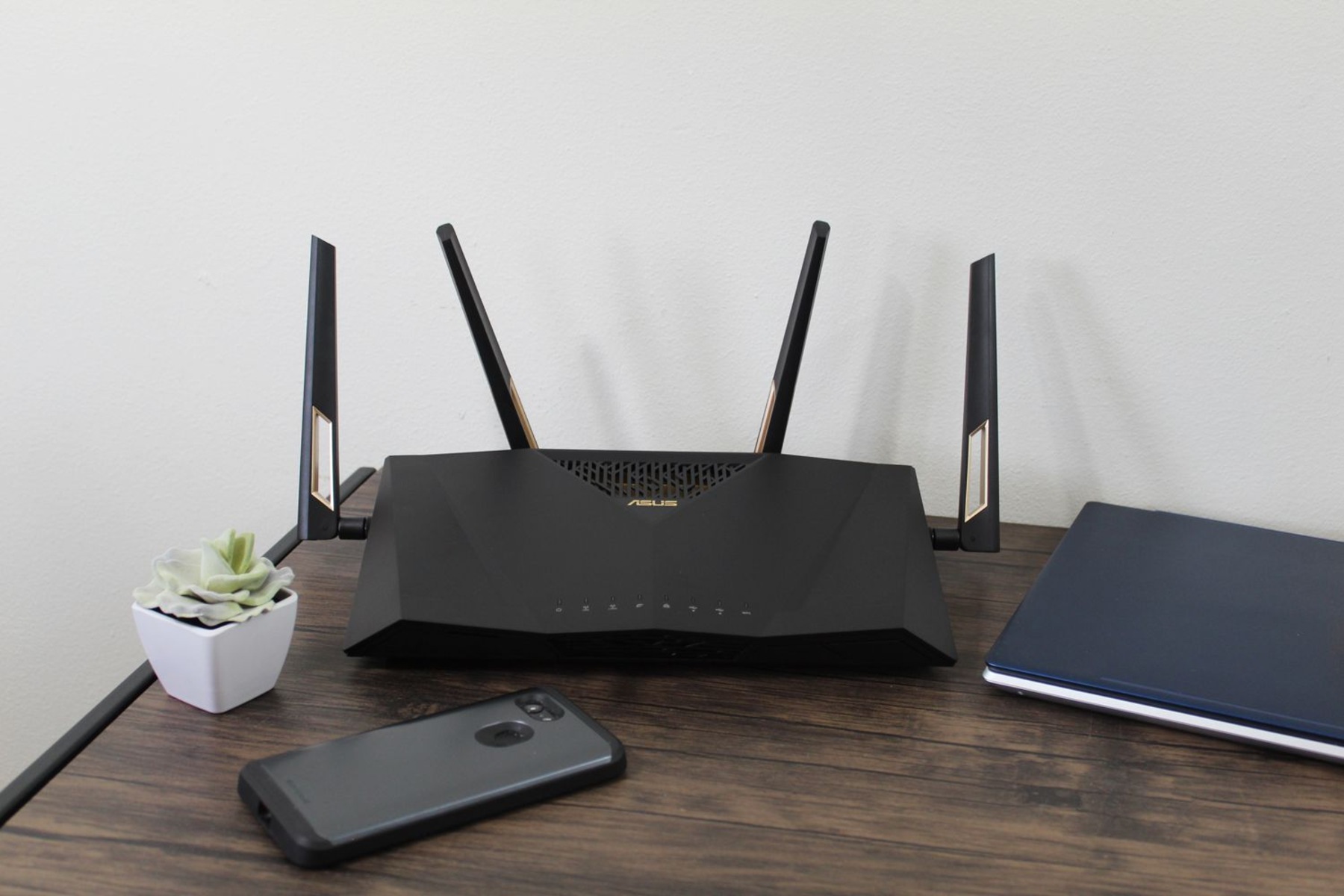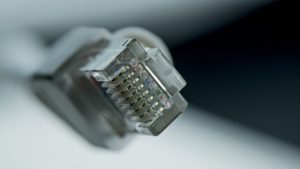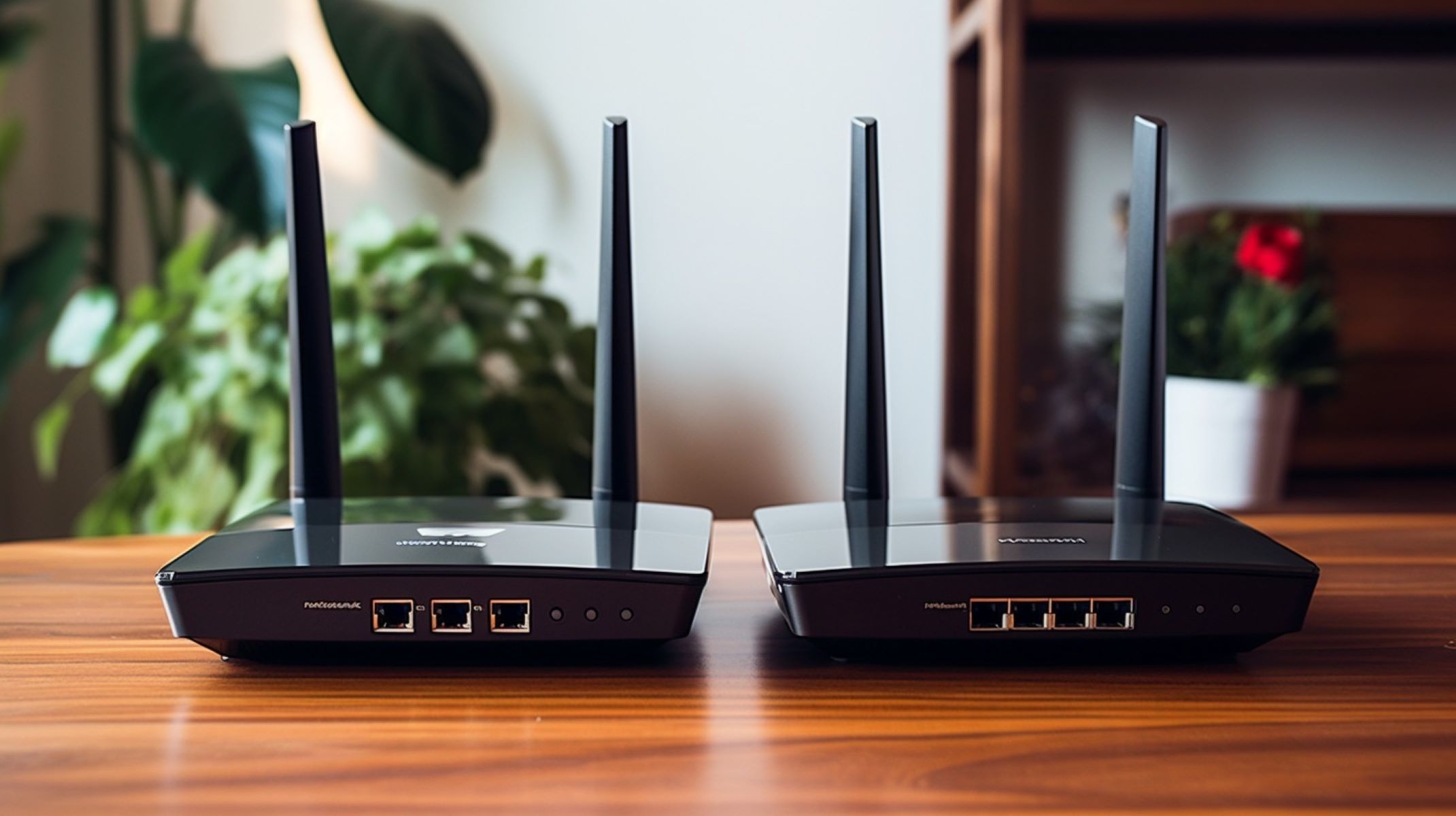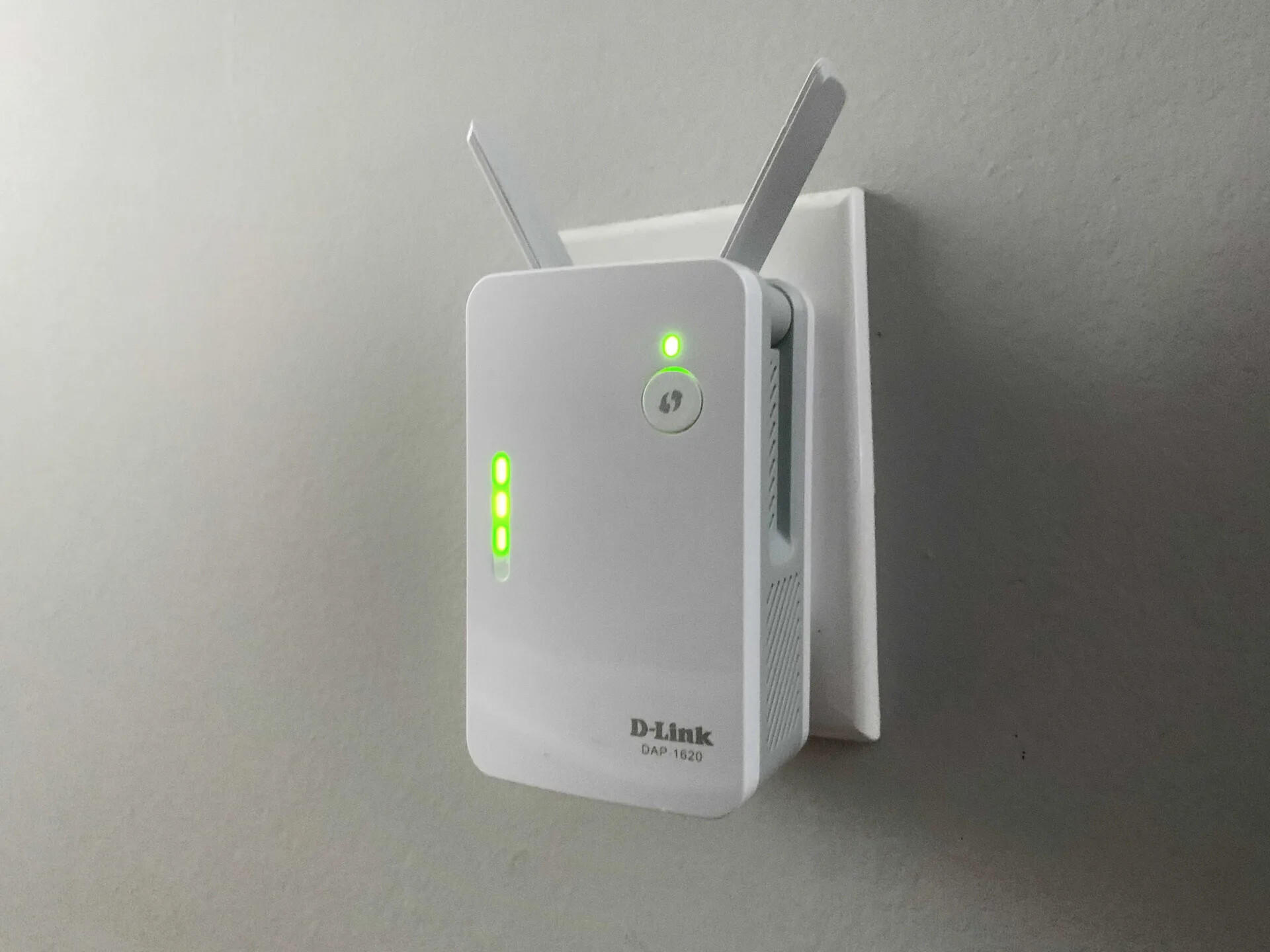Introduction
Welcome to the world of wireless routers, where the internet is at our fingertips without any cumbersome wires. These devices have become an essential part of our daily lives, providing us with the convenience of connecting to the internet from anywhere within our homes or offices. However, as convenient as wireless routers are, one common concern is the speed at which they transmit data.
When it comes to wireless router speed, there are a multitude of factors that can impact performance. From the wireless standards and frequencies it supports to the level of interference in the area, various elements can affect the overall speed and reliability of your wireless connection. Understanding these factors is important in order to optimize the performance and get the most out of your wireless router.
In this article, we will delve into the key factors that affect wireless router speed and help you understand how these factors can impact the performance of your router. Whether you are a casual user looking to stream videos seamlessly or a professional relying heavily on a stable and fast internet connection, this information will be valuable in maximizing the potential of your wireless router.
By exploring the impact of wireless standards, frequency bands, interference, number of connected devices, distance from the router, signal strength, security measures, and router hardware, you will gain a comprehensive understanding of the different elements that can affect your wireless router’s speed.
So, let’s dive in and discover how these factors, individually and collectively, can impact the speed of your wireless router. Armed with this knowledge, you will be better equipped to make informed decisions when it comes to purchasing, setting up, and optimizing your wireless router for optimal speed and performance.
Factors Affecting Wireless Router Speed
When it comes to the speed of your wireless router, several factors come into play. Understanding these factors can help you troubleshoot any issues you may encounter and optimize the performance of your router. Let’s explore the key elements that can affect the speed of your wireless router:
- Wireless Standards: The wireless standard your router supports can significantly impact its speed. The older standards like 802.11b and 802.11g offer slower speeds compared to the newer standards such as 802.11n and 802.11ac. Upgrading to a router that supports the latest wireless standard can potentially improve your wireless connection speed.
- Frequency Bands: Wireless routers operate on two frequency bands – 2.4 GHz and 5 GHz. The 2.4 GHz band provides wider coverage but is more susceptible to interference. The 5 GHz band, on the other hand, offers faster speeds but with a shorter range. Choosing the right frequency band can have a significant impact on your wireless router’s speed.
- Interference: Interference from other electronic devices, such as microwaves and cordless phones, can disrupt the wireless signal and reduce the speed of your router. Additionally, neighboring Wi-Fi networks operating on the same channel or nearby channels can also cause interference. Minimizing the interference by keeping your router away from other electronic devices and selecting a less congested Wi-Fi channel can help improve your router’s speed.
- Number of Connected Devices: The more devices connected to your wireless router, the more it has to divide its bandwidth among them, potentially reducing the speed for each device. If you have multiple devices connected simultaneously, consider limiting the number of active connections or investing in a router with better bandwidth management capabilities.
- Distance from the Router: The further away you are from your wireless router, the weaker the signal becomes, leading to decreased speed. Walls, floors, and other obstacles can also affect signal strength. Consider placing your router in a central location and closer to the areas where you need a stronger signal to improve speed and coverage.
- Signal Strength and Quality: A weak or unstable wireless signal can result in slower speeds or frequent disconnections. Ensuring a strong and stable signal by positioning your router correctly, using range extenders, or upgrading to a router with better antenna technology can enhance the speed and reliability of your wireless connection.
- Security Measures: Enabling robust security measures, such as WPA2 encryption, on your wireless network can help protect your data but may also slightly reduce the speed. Finding the right balance between security and speed is essential. Ensure that you have the necessary security measures in place but avoid overloading your network with excessive security protocols that may hinder speed.
- Router Hardware: The hardware components of your router, including the processor, RAM, and antenna technology, can impact its speed and performance. Investing in a router with a powerful processor and ample memory can improve its ability to handle multiple connections and provide faster speeds.
By considering these factors and making necessary adjustments, you can optimize the speed and performance of your wireless router. Experimenting with different configurations and settings might be necessary to find the optimal setup for your specific needs. Remember to regularly update your router’s firmware to ensure you have the latest features and enhancements for speed and security.
Wireless Standards and Their Impact on Speed
The wireless standards supported by your router can have a significant impact on its speed. As technology advances, newer standards are introduced to provide faster and more efficient wireless connections. Let’s take a closer look at the different wireless standards and their impact on speed:
802.11b: This was one of the earliest wireless standards introduced, offering a maximum speed of 11 Mbps. While it may still be suitable for basic internet browsing, it is significantly slower compared to modern standards.
802.11g: Introduced as an improvement over 802.11b, 802.11g provides a maximum speed of 54 Mbps. It offers better range and improved support for multimedia applications but is still considered relatively slow by today’s standards.
802.11n: 802.11n is one of the most commonly used wireless standards today. It offers speeds up to 300 Mbps or even higher with multiple antennas. This standard provides better range and stability, making it ideal for streaming HD videos, online gaming, and other bandwidth-intensive activities.
802.11ac: The latest widely adopted wireless standard is 802.11ac, also known as Wi-Fi 5. It provides higher speeds and improved performance compared to 802.11n. With multi-stream support and wider frequency channels, 802.11ac offers speeds up to several gigabits per second, making it ideal for demanding applications and high-bandwidth tasks.
802.11ax: The newest wireless standard, 802.11ax, or Wi-Fi 6, is designed to handle the increasing demands of our connected world. It offers even higher speeds, improved capacity, and better performance in congested environments. With features like OFDMA and MU-MIMO, 802.11ax provides faster and more efficient connectivity for multiple devices simultaneously.
Upgrading to a router that supports the latest wireless standard, such as 802.11ac or 802.11ax, can significantly improve your wireless connection speed. However, it’s important to note that your devices need to support these standards as well to take full advantage of the higher speeds.
When purchasing a new router, always check the supported wireless standards and ensure they align with your specific requirements. Investing in a router that supports the latest standards will future-proof your network and provide the best possible speed and performance.
Remember that while wireless standards play a crucial role in determining the speed of your wireless connection, other factors such as interference, distance, and the number of connected devices also have an impact. It’s important to consider these factors collectively when optimizing your wireless router’s speed.
4 GHz vs 5 GHz: Which Frequency Band is Faster?
When it comes to wireless routers, two frequency bands are commonly used: 2.4 GHz and 5 GHz. Understanding the differences between these two bands can help you determine which one is faster and more suitable for your needs. Let’s compare the 2.4 GHz and 5 GHz frequency bands:
2.4 GHz: The 2.4 GHz band has been around for a long time and is used by most Wi-Fi devices. It offers good coverage and can penetrate walls and other obstacles more effectively than higher frequency bands. However, one drawback of the 2.4 GHz band is its susceptibility to interference from other electronic devices, such as cordless phones and microwaves. Additionally, since this frequency band is commonly used, there can be congestion and signal overlap from neighboring Wi-Fi networks operating on the same or nearby channels.
5 GHz: The 5 GHz band provides faster speeds and less interference compared to the 2.4 GHz band. With wider available channels and less congestion, it offers a more reliable and efficient wireless connection. The 5 GHz band is less prone to interference from other devices, thanks to the lower number of devices using this frequency band. However, it is important to note that the 5 GHz band has a shorter range compared to the 2.4 GHz band, which means that the signal strength may degrade more rapidly over longer distances.
So, which frequency band is faster? The answer depends on several factors. While the 5 GHz band offers faster speeds and less interference, it may not provide the same coverage as the 2.4 GHz band. If you are in close proximity to your router and require high-speed connections for bandwidth-intensive activities like streaming 4K videos or online gaming, the 5 GHz band is the better option. On the other hand, if you have devices that are located further away from the router or if you prioritize wider coverage over peak speed, the 2.4 GHz band may be more suitable.
In many cases, a dual-band router that supports both 2.4 GHz and 5 GHz frequencies is the ideal solution. This allows you to take advantage of the faster speeds offered by the 5 GHz band when you are in close proximity to the router, while still being able to provide wider coverage with the 2.4 GHz band for devices located further away.
To optimize the speed and performance of your wireless router, consider factors such as the number of connected devices, interference in your area, and the purpose of your internet usage. By selecting the appropriate frequency band and making necessary adjustments, you can ensure a fast and reliable wireless connection that meets your specific needs.
Interference and Its Effect on Wireless Router Speed
Interference from various sources can have a significant impact on the speed and performance of your wireless router. Understanding the types of interference and how they affect your wireless connection can help you mitigate their effects and optimize your router’s speed. Let’s explore the different types of interference and their effect on wireless router speed:
Physical Interference: Physical objects such as walls, floors, and furniture can obstruct the wireless signal and reduce the speed and range of your router. Thick walls and floors made of concrete or metal can be particularly problematic, as they cause signal degradation. Positioning your router in a central location and minimizing the number of obstacles between the router and your devices can help improve signal strength and minimize physical interference.
Electrical Interference: Electrical devices and appliances such as cordless phones, microwave ovens, and baby monitors can generate electromagnetic interference, which can disrupt the Wi-Fi signal and cause speed issues. These devices operate on similar frequency bands as Wi-Fi, especially in the 2.4 GHz range, causing interference and reducing the overall speed of your router. Keep your router away from such devices and minimize their usage during critical internet activities to reduce electrical interference.
Neighboring Wi-Fi Networks: The proliferation of Wi-Fi networks in residential areas and crowded environments can lead to interference. When multiple Wi-Fi networks operate on the same or nearby channels, they can cause signal overlap and congestion, reducing the speed of your router. To mitigate this interference, choose a less congested Wi-Fi channel for your router manually or utilize the automatic channel selection feature available in some routers.
Co-channel Interference: Even if neighboring Wi-Fi networks operate on different channels, there can still be interference if their signal strength is high. This is known as co-channel interference. A strong neighboring Wi-Fi network can overpower the signal of your router, resulting in reduced speed and performance. To combat co-channel interference, consider increasing the distance between routers or using routers with better antenna technology to improve signal strength.
Bluetooth and other Wireless Devices: Bluetooth devices, wireless speakers, and other wireless gadgets operating in the 2.4 GHz frequency range can cause interference with your Wi-Fi signal. Since these devices use the same frequency range, they can compete for the available bandwidth, impacting your router’s speed. To minimize interference from Bluetooth devices, keep your router away from them or switch to the less crowded 5 GHz frequency band if your devices support it.
To minimize interference and optimize the speed of your wireless router, consider the following steps:
- Place your router in a central location, away from physical obstructions and devices that can cause interference.
- Select a Wi-Fi channel with less congestion, avoiding the overlapping channels of nearby networks.
- Minimize the use of other wireless devices or keep them away from your router to reduce interference.
- Upgrade to a dual-band router that supports both 2.4 GHz and 5 GHz frequencies, allowing you to switch to the less congested band if needed.
- Consider using Wi-Fi range extenders or mesh network systems to extend the coverage and improve signal quality in large homes or areas with weak signal strength.
By addressing interference issues, you can improve the speed and reliability of your wireless connection. Experiment with different settings and configurations to find the optimal setup for your environment and minimize interference, thus ensuring a fast and stable wireless connection.
Number of Connected Devices and Bandwidth Usage
The number of devices connected to your wireless router and their bandwidth usage can have a direct impact on its speed and performance. Understanding how the number of connected devices and their bandwidth requirements affect your router can help you manage your network more effectively. Let’s explore the relationship between the number of connected devices and bandwidth usage:
Bandwidth Allocation: Your router divides its available bandwidth among connected devices, with each device receiving a portion of the total bandwidth. As the number of connected devices increases, the available bandwidth per device decreases, potentially leading to slower speeds for each device. Bandwidth-intensive activities such as streaming high-definition videos or online gaming can further strain the network, impacting the overall speed for all connected devices.
Quality of Service (QoS): Many modern routers offer Quality of Service (QoS) features that prioritize network traffic based on specific criteria. By prioritizing certain devices or applications, you can ensure that critical activities, such as video conferencing or online gaming, receive sufficient bandwidth even when other devices are connected and consuming bandwidth. Utilizing QoS settings can help optimize the speed and performance of your wireless router, especially when dealing with a large number of connected devices.
Network Congestion: The more devices connected to your wireless router, the more likely it is to experience network congestion. Network congestion occurs when the available bandwidth is divided among numerous devices simultaneously trying to access the internet, leading to decreased speeds for all connected devices. During peak usage times, when many devices are active on the network, you may notice a noticeable slowdown in speed. Managing network congestion by limiting the number of connected devices or prioritizing critical activities can help alleviate these issues.
Bandwidth Requirements: Different devices and activities have varying bandwidth requirements. For example, streaming high-definition videos or online gaming typically require more bandwidth compared to web browsing or emailing. Understanding the bandwidth requirements of your devices and activities can help manage your network more effectively. Identifying devices or applications that are consuming a significant amount of bandwidth and adjusting their usage or allocating more bandwidth to them can prevent overall speed degradation for all devices.
Router Capacity: The capacity and capabilities of your router also play a role in dealing with a large number of connected devices. Older routers or entry-level models may struggle to handle numerous connections and bandwidth-intensive activities simultaneously, leading to reduced speed and performance. Upgrading to a more robust router with better processing power and advanced features can help accommodate a larger number of devices and improve overall speed and performance.
To optimize the speed and performance of your wireless connection with multiple devices, consider the following steps:
- Evaluate the number of connected devices, ensuring that each device justifies its presence on the network.
- Implement network usage policies or schedule bandwidth-heavy activities during non-peak hours to avoid congestion.
- Utilize Quality of Service (QoS) settings to prioritize critical devices or applications that require higher bandwidth.
- Upgrade to a more powerful router that can handle the capacity and bandwidth demands of multiple devices.
- Consider implementing a guest network to separate guest devices from your main network, reducing the impact on your bandwidth resources.
By effectively managing the number of connected devices and their bandwidth usage, you can optimize the speed and performance of your wireless router. Prioritizing critical activities, understanding the capabilities of your router, and making necessary adjustments will ensure a smooth and efficient network experience for all connected devices.
Distance from the Wireless Router
The distance between your device and the wireless router can have a significant impact on the speed and quality of your wireless connection. Understanding how distance affects the performance of your router can help you optimize its speed and coverage. Let’s explore the relationship between distance and wireless router performance:
Signal Strength and Attenuation: As you move further away from your router, the signal strength decreases. The signal weakens due to various factors such as walls, floors, and other obstacles that the signal must pass through. This attenuation, or signal loss, translates into decreased speed and range. The signal strength can also be affected by the type of building materials or interference from other electronic devices.
Speed Degradation: As the signal weakens with distance, the speed and quality of the wireless connection are affected. You may experience slower download and upload speeds, increased latency, and intermittent or dropped connections. This degradation in speed and performance can make it challenging to stream high-definition videos, engage in online gaming, or perform other bandwidth-intensive activities when located far away from the router.
Router Placement: The placement of your wireless router plays a crucial role in the distance it can cover and the signal strength it can provide. Ideally, the router should be positioned in a central location, away from obstructions and interference-causing objects. Placing the router on a higher level or using external antennas can help extend the coverage and improve the signal strength, allowing for better speed and connectivity across larger distances.
Signal Boosting: To overcome the distance-related performance issues, you can employ signal boosting techniques. One common method is using a Wi-Fi extender or repeater, which amplifies the existing signal and extends its range. Another option is using a mesh network system, where multiple access points are strategically placed to provide seamless coverage throughout the area. These solutions can improve the speed and connectivity in distant areas from the router.
Power Considerations: Some routers offer adjustable power settings, allowing you to increase or decrease the transmitting power. While increasing the power may enhance the signal reach, it can also interfere with neighboring networks and cause congestion. Striking the right balance between signal strength and interference avoidance is essential to optimize both speed and network performance.
To optimize the speed and performance of your wireless connection in relation to distance, consider the following steps:
- Position the router in a central location, away from obstructions and interference-causing objects.
- Use external antennas or consider upgrading to a router with better antenna technology.
- Consider using Wi-Fi extenders, repeaters, or mesh network systems to extend the signal range.
- Adjust the router’s power settings to a level that provides a balance between signal strength and interference avoidance.
- Investigate alternative options, such as powerline adapters or MoCA (Multimedia over Coax Alliance) devices, to extend the network using existing electrical or coaxial wiring.
By optimizing the placement of your router and employing signal boosting techniques, you can mitigate the effects of distance on your wireless connection. This will help ensure a reliable and fast internet experience, regardless of your proximity to the router.
Signal Strength and Quality
The signal strength and quality of your wireless connection play a crucial role in determining the speed and reliability of your internet connection. Understanding how signal strength and quality affect your wireless router’s performance can help you optimize its speed and stability. Let’s explore the importance of signal strength and quality in wireless connections:
Signal Strength: Signal strength refers to the power of the wireless signal transmitted by your router. A stronger signal indicates a higher power level, allowing for faster and more reliable connections. When the signal is weak, due to distance or obstacles, it can result in slower speeds, dropped connections, and overall diminished performance. Monitoring signal strength is crucial in identifying areas where the signal is weak and optimizing the router’s placement or utilizing additional signal-boosting devices.
Signal Quality: Signal quality refers to the overall health and consistency of the wireless signal. Even if the signal strength is strong, factors such as interference, noise, and packet loss can degrade the signal quality, negatively impacting the speed and reliability of your internet connection. Monitoring signal quality is essential to identify and mitigate factors that affect the performance, such as neighboring Wi-Fi networks, electronic devices, or physical obstacles.
Signal-to-Noise Ratio (SNR): The signal-to-noise ratio measures the ratio of the desired signal’s strength to the background noise level. A higher SNR indicates a better quality signal, while a lower SNR indicates increased noise interference. Interference from other electronic devices or neighboring Wi-Fi networks can increase the noise, leading to a lower SNR. Maintaining a high SNR by reducing noise sources and minimizing interference is crucial for optimizing the speed and performance of your wireless connection.
Signal Dead Zones: Signal dead zones are areas where the wireless signal is weak or absent. These zones can occur due to physical obstacles, distance from the router, or signal interference. Signal dead zones not only result in poor performance in those areas but can also affect the overall network speed if devices continuously attempt to connect or reconnect to the router. Identifying and resolving signal dead zones, using techniques like signal boosters or strategically placed access points, can improve the speed and coverage of your wireless network.
Monitoring and Optimizing Signal: Monitoring your router’s signal strength and quality can provide valuable insights into areas of improvement. Utilize tools like Wi-Fi analyzers or signal strength meters to identify signal dead zones, measure signal strength and quality, and detect sources of interference. Consider optimizing your router’s placement, upgrading to a more capable router, adjusting antenna positions, or utilizing additional signal-boosting devices to improve signal strength and quality.
Router Maintenance: Regular router maintenance, including firmware updates and periodic optimization, can help maintain optimal signal strength and quality. Firmware updates often include bug fixes, security enhancements, and performance improvements that can positively impact the router’s speed and stability. Be sure to check for firmware updates regularly and follow manufacturer guidelines for router optimization.
By paying attention to signal strength and quality, you can optimize the speed and reliability of your wireless connection. Monitoring these factors, identifying and resolving signal dead zones, reducing sources of interference, and performing regular maintenance will help ensure a consistently strong, high-quality signal, enabling you to enjoy fast and stable internet connectivity.
Security Measures and Encryption
Security measures and encryption play a vital role in protecting your wireless network from unauthorized access and ensuring the privacy and integrity of your data. Understanding the importance of security measures and encryption is essential in maintaining a secure and reliable wireless connection. Let’s explore the significance of security measures and encryption for your wireless router:
Wireless Network Security: Securing your wireless network is crucial to prevent unauthorized access and protect your personal information. Leaving your network unsecured can allow anyone within range to connect to your router and potentially gain access to your internet connection and sensitive data. Implementing security measures helps establish a barrier against unauthorized access, ensuring that only authorized devices can connect to your network.
Encryption: Encryption plays a critical role in securing the data transmitted over your wireless network. Encryption algorithms scramble your data using complex mathematical formulas, making it unreadable to unauthorized users. Only devices with the correct encryption keys can decrypt and understand the transmitted data. Utilizing encryption ensures that your data remains confidential and protected from eavesdropping or interception.
Wi-Fi Protected Access (WPA/WPA2): WPA/WPA2 is the most commonly used wireless encryption protocol. It provides strong security measures, including encryption and authentication, to protect your data from unauthorized access. It is important to ensure that your router is set to use WPA2 with a strong password, as older encryption methods like WEP are no longer considered secure.
Network Password: Setting a strong and unique password for your wireless network is essential to prevent unauthorized access. Avoid using easily guessable passwords and consider using a combination of uppercase and lowercase letters, numbers, and special characters. Changing your password periodically adds an additional layer of security to your network.
Guest Network: Many modern routers support the creation of a guest network, separate from your main network. Guest networks allow visitors to access your internet connection without gaining access to your main network, safeguarding your private data. Enabling guest networks ensures that personal devices are isolated from potentially unfamiliar or untrusted devices.
Firewall: A firewall is a security feature that monitors and regulates incoming and outgoing network traffic, acting as a barrier between your network and the internet. It can block unauthorized access attempts, filter out potentially malicious traffic, and detect and prevent network intrusions. Enabling and properly configuring the firewall on your router provides an additional layer of security for your wireless network.
Security Updates: Regularly updating your router’s firmware is vital in maintaining its security. Manufacturers often release firmware updates that address security vulnerabilities, enhance performance, and introduce new features. Staying up to date with these updates ensures that your router benefits from the latest security enhancements and patches.
Implementing strong security measures and encryption protocols is crucial in safeguarding your wireless network from potential threats. By securing your network, utilizing encryption, setting strong passwords, enabling guest networks, and keeping your router’s firmware up to date, you can ensure the privacy, security, and reliability of your wireless connection.
Router Hardware and Technology
The hardware components and technology used in your wireless router have a significant impact on its speed, performance, and overall capabilities. Understanding the importance of router hardware and technology can help you make informed decisions when selecting and optimizing your wireless router. Let’s explore the key aspects of router hardware and technology:
Processor and Memory: The processor and memory of your router play a crucial role in its performance. A powerful processor enables efficient handling of network traffic, while ample memory allows for smooth multitasking and better performance under heavy loads. When choosing a wireless router, consider models with faster processors and higher memory capacities to ensure optimal speed and responsiveness.
Antenna Technology: The antenna technology used in your router affects its signal range, coverage, and overall performance. Routers with external antennas can often be positioned and adjusted to optimize signal strength, improving the speed and coverage. High-gain antennas can provide an extended range, especially in larger homes or areas with many obstacles. Upgrading to a router with advanced antenna technology can significantly enhance the performance and reliability of your wireless connection.
Multiple-Input Multiple-Output (MIMO): MIMO technology, such as 2×2 or 3×3 MIMO, utilizes multiple antennas to transmit and receive data simultaneously. This technology improves the capacity and overall performance of your wireless network. By allowing the router to communicate with multiple devices concurrently, MIMO can increase the speed and efficiency of data transmission, especially in environments with multiple connected devices.
Beamforming: Beamforming is a technology that focuses the wireless signal directly towards the connected devices, rather than transmitting it in all directions. This targeted signal transmission enhances signal strength, range, and the overall quality of the connection. Routers equipped with beamforming technology can deliver faster and more reliable speeds, especially to devices located further away from the router.
Advanced Wireless Standards: Routers supporting the latest wireless standards, such as 802.11ac or 802.11ax, benefit from faster speeds, improved performance, and enhanced features. These standards offer higher data transfer rates, increased capacity, better range, and backward compatibility with older devices. Upgrading to a router that supports the latest wireless standards can maximize the speed and capabilities of your wireless network.
Advanced Features: Modern routers often come equipped with advanced features that can enhance your wireless experience. These features include parental controls for managing internet access and content, quality of service (QoS) settings for prioritizing specific devices or applications, and USB ports for connecting devices like printers or storage devices. Evaluating the available features and selecting a router that aligns with your specific needs can improve the functionality and versatility of your network.
Router Firmware: The firmware of your router is the software that controls its operation. Regular firmware updates from the manufacturer often include bug fixes, security patches, and performance enhancements. Keeping your router’s firmware up to date ensures that you benefit from the latest features, improvements, and security measures for optimized speed and performance.
When selecting a wireless router, consider the router’s hardware specifications, antenna technology, MIMO capabilities, beamforming support, and compatibility with advanced wireless standards. Additionally, regularly updating your router’s firmware and exploring its advanced features can further enhance its speed, performance, and functionality. By understanding router hardware and technology, you can make informed decisions and optimize your wireless network for the best possible speed and performance.
Conclusion
Optimizing the speed and performance of your wireless router is essential for a seamless internet experience. By understanding the various factors that affect wireless router speed, you can make informed decisions when setting up and optimizing your network. From considering wireless standards and frequency bands to managing interference, distance, and the number of connected devices, every aspect plays a crucial role in determining the speed and reliability of your wireless connection.
Choosing a router that supports the latest wireless standards, such as 802.11ac or 802.11ax, can provide faster speeds and improved performance. Selecting the appropriate frequency band, whether 2.4 GHz or 5 GHz, based on your specific needs and coverage requirements is also important. Minimizing interference from other devices, neighboring networks, and physical obstacles can help improve signal strength and speed.
Managing the number of connected devices, understanding their bandwidth usage, and utilizing Quality of Service (QoS) settings can optimize the network’s performance and ensure a consistent speed for all devices. Additionally, considering the distance from the router, the signal strength and quality, and the security measures implemented are critical factors to enhance the speed and reliability of your wireless connection.
Remember to regularly update your router’s firmware, explore advanced features, and maintain the hardware to maximize performance. Experimenting with different configurations, adjusting settings, and using signal-boosting techniques like extenders or mesh network systems can further improve speed and coverage.
By applying the knowledge gained from understanding these factors and implementing the appropriate optimizations, you can create a fast, reliable, and secure wireless network that meets your specific needs. Take the time to evaluate your current setup, identify areas for improvement, and make the necessary adjustments to create an optimized wireless connection.
With an optimized wireless router that delivers fast and reliable speeds, you can enjoy seamless internet browsing, smooth streaming of multimedia content, lag-free online gaming, and efficient data transfers. Stay informed, stay connected, and make the most of your wireless network!

























